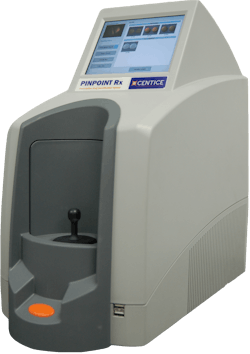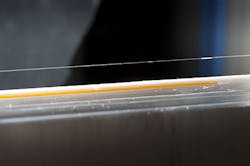INSIDE INSTRUMENTATION: Optics and photonics enable point-of-care solutions

Two emergency medical technicians quickly wheel a nonresponsive 74-year-old man into an emergency room. While a physician works to assess the patient, a nurse finds a handful of pills in the man’s coat pocket. Without a prescription bottle, it could take hours to identify each pill by hand. With the right instrument, however, the nurse could learn the identity of each pill within seconds.
Such a device already exists. In fact, inexpensive and small devices will soon change a range of public-health concerns. More and more, miniaturized instruments are able to detect dangers in the field, where immediate access to information can make a critical difference.
The pill-identification system began to emerge at Duke University when Prasant Potuluri—now chief technology officer for Centice (Morrisville, NC)—was working on his doctoral thesis. Potuluri wanted to make more use of computational Raman spectroscopy, which measures the change in the frequency of photons when monochromatic light interacts with a sample.
Today, this technology runs PINPOINT Rx, a Centice product that identifies prescription pharmaceutical capsules and tablets (see Fig. 1). This device uses near-infrared light of 785 nm to generate a Raman spectrogram of a sample, which can even be a pill fragment, and then compares it with a database of 3,000 unique drugs. In just a few seconds, the device spits out a pill’s name. “The majority of drugs have a very distinct fingerprint,” Potuluri says. For the dosage, though, a pill’s size or shape must be considered as well.
While the system measures 17 × 17 × 8.5 in., the technology can also be made small enough to carry into the field. Centice is currently running a beta test on a portable version that a narcotics squad is testing as a tool against prescription-drug abuse.
Beyond its small size, the unit comes with a small price tag. “It’s the cheapest Raman spectrometer on the market today,” says Potuluri. “Most others cost $20,000 to 50,000, and ours is under $10,000.”
Searching for select agents
Although unidentified prescription drugs pose considerable danger, so-called select agents raise even more concern. These pathogens or biological toxins—such as Bacillus anthracis, which causes anthrax—can create serious public-health hazards, especially if used in bioterrorism.
Select agents played a role at Virginia Tech in Blacksburg when professor of physics Randy Heflin and Tom Inzana, Tyler J. and Frances F. Young Professor of Bacteriology, met in search of an interdisciplinary project. For this team, Inzana brought experience in working with select agents and developing diagnostic tests, and Heflin contributed his experience with optoelectronic devices. They put together that knowledge to make a portable biosensor (see Fig. 2).The sensor starts with an optical fiber that they expose to a laser to add a long-period grating. “This gives a strong, discrete decrease in transmission at specific wavelengths,” Heflin explains. Then, ionic self-assembly adds 1 nm layers, one by one. The long-period grating and the layers—if done just right—make a device that decreases the intensity of a specific wavelength by 20 to 50 times with the binding of 1 nm of material to the surface of the fiber.
To grab a specific agent, Inzana and Heflin add receptors to the optical fiber’s surface. For example, an antibody can be attached to capture a specific antigen. As the target molecules bind to the outside of the fiber, it reduces the transmitted light, which can be measured with a very simple light detector, one tuned to the wavelength that the grating attenuates.
“You can use a diode laser, like the ones used at supermarket checkout counters, and use the optical fiber to couple that to a photodetector,” Heflin explains.
Although this team is still working on a prototype, the ultimate device could be as small as a laptop computer, maybe even smaller. They’ve been testing it on methicillin-resistant Staphylococcus aureus (MRSA), which is especially important to them because Heflin’s daughter contracted this infection a year or so ago. With available technology, it took a couple days to diagnose her, but Heflin says, “our device in a physician’s office could have provided a result in an hour.”
So far, this device works great on MRSA in water, but real samples will not be so clean. “We’re in the process of getting blind clinical samples to test,” Inzana says. In addition, he points out that this device could also detect a sample’s DNA. “We can improve the specificity that way,” he says.
As this technology evolves, it will go beyond select agents and healthcare. Inzana and Heflin already foresee other applications. For example, Inzana mentions that brucellosis, a bacterial infection, lacks a good diagnostic test. Right now, this infection appears largely in elk, which can transmit the agent to farm animals. “We could develop a rapid field test that could be used to identify Brucella in wild animals and treat them before they could transmit the agent to farm animals,” Inzana says. “It could also be used in quality control in the food industry.”
Dialing in diabetes
Around the world, a couple hundred million people already suffer from diabetes, and that number keeps growing. To manage this disease today, patients prick a finger and read the blood glucose level with a handheld device. Several companies hope to improve that technology by eliminating the finger prick.
For example, PositiveID Corporation (Delray Beach, FL), is developing its Easy Check Breath Glucose Detection Device. Rather than pricking a finger, a diabetic patient will blow into this device. “It’s much like a breathalyzer,” says Allison Tomek, senior vice president of investor relations and corporate communications at PositiveID. Inside, a single-use capsule and its proprietary chemistry read the breath’s acetone level, which correlates with the glucose levels in the blood.
The prototype instrument relies on some off-the-shelf parts, including a laser from Edmund Optics (Barrington, NJ). The prototype is a tubular shape that is about 8 inches long, 4 wide and 2 deep. The production device, though, will be somewhat smaller. For now, the company continues lab tests and aims at clinical trials, possibly starting in the next year.
About the Author
Mike May
Contributing Editor, BioOptics World
Mike May writes about instrumentation design and application for BioOptics World. He earned his Ph.D. in neurobiology and behavior from Cornell University and is a member of Sigma Xi: The Scientific Research Society. He has written two books and scores of articles in the field of biomedicine.
